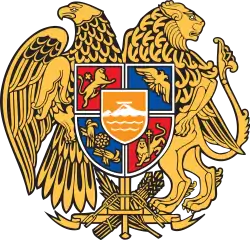Goris
Goris (Armenian: Գորիս) is a town and the centre of the urban community of Goris, in Syunik Province at the south of Armenia. Located in the valley of river Goris (or Vararak), it is 254 km from the Armenian capital Yerevan and 67 km from the provincial center Kapan. Goris is the second-largest city in Syunik in terms of population. During the 2011 census, it had a population of 20,591, down from 23,261 reported at the 2001 census.[2] However, as per the 2016 official estimate, the population of Goris was 20,300.[3] Goris is the seat of the Diocese of Syunik of the Armenian Apostolic Church.
Goris
Գորիս | |
|---|---|
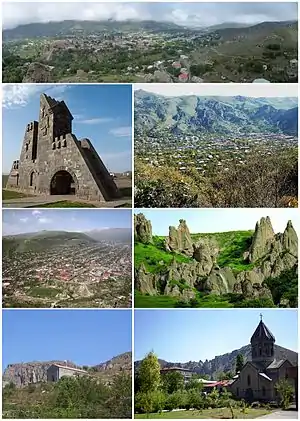 From top left: Panoramic view of Goris Goris gate • Zangezur Mountains around Goris Goris skyline • Settlement of old Kores Surp Hripsimé Basilica • Saint Gregory Cathedral | |
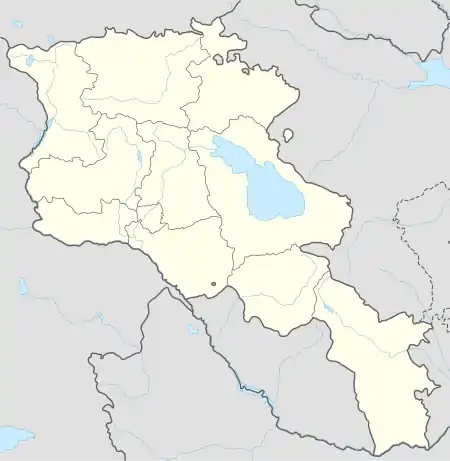 Goris | |
| Coordinates: 39°30′28″N 46°20′19″E | |
| Country | |
| Province | Syunik |
| Municipality | Goris |
| Established | 1870 |
| Government | |
| • Mayor | Arush Arushanyan |
| Area | |
| • Total | 8 km2 (3 sq mi) |
| Elevation | 1,250−1,520 m (−3,740 ft) |
| Population (2011)[1] | |
| • Total | 20,591 |
| • Density | 2,600/km2 (6,700/sq mi) |
| Time zone | UTC+4 (AMT) |
| Area code(s) | +374(284) |
| Website | Official website |
Following the administrative reforms in 2016, the community of Goris was enlarged to include the surrounding villages of Akner, Bardzravan, Hartashen, Karahunj, Khndzoresk, Nerkin Khndzoresk, Shurnukh, Verishen, and Vorotan.[4]
Etymology
Throughout its history, Goris has been known as Kores and Gorayk. However, there are several explanations for the origin of the name. It is supposed that the name Goris is derived from the Indo-European prelanguage words "gor" (rock), "es" (to be), i.e. Goris/Kores meaning a rocky place. There was a dwelling in the ancient times in the same area of the town.
The name Goris had many variants including: Goristsa, Kores, Gores, Gorayk, Goru, and Geryusy.
History
Ancient history and Middle Ages
_(11).jpg.webp)
The area of Goris has been settled since the Stone Age. Goris was first mentioned in the history by the Urartian period. King Rusa I of Urartu who reigned between 735 and 713 BC, left a cuneiform, where he mentioned that among the 23 countries conquered by him, Goristsa country was one of them. The scientists suppose that it is the same Goris.
During the Middle Ages, the town-settlement was situated in the eastern part of the present Goris, on the left bank of Goris river. It was called Kores and coincided with one of the villages of Goru and Gorayk mentioned by Stephen Orbelian in his 13th-century work History of Syunik Province.
Between the 12th and 15th centuries, Syunik along with the rest of the historic territories of Armenia suffered from the Seljuk, Mongol, Aq Qoyunlu and Kara Koyunlu invasions, respectively.
Persian rule
At the beginning of the 16th century, Syunik became part of the Erivan Beglarbegi within the Safavid Persia. The current spelling of the name was first mentioned in 1624, in a handwriting by Barsegh Yerets. In the 17-18th centuries princes Melik Husenyans ruled the region.
At the beginning of the 18th century, the region was the centre of the Armenian liberation campaign led by David Bek, against Safavid Persia and the invading Ottoman Turks.[5] In 1750, the region became part of the newly-formed Karabakh Khanate.
At the beginning of the 19th century, many territories of Armenia -including the region of old Kores of Syunik-, became part of the Russian Empire as a result of the Treaty of Gulistan signed on 24 October 1813, between Russia and Qajar Iran following the Russo-Persian War of 1804–13.
Russian rule
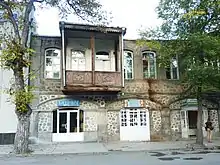
Under the Russian rule, the town of Goris was founded in 1870 to become the centre of Zangezursky Uyezd, within the Elisabethpol Governorate of the Russian Empire. In 1876, the construction of new Goris was completed near the old town of Kores, with the initiative of the head of "Starastky province" and recommendation of Prince Manuchar-Bek Melik Husenyan, and the major city plan designed by a German architect.[6] At the end of the 19th century the economical and cultural life of the town was greatly improved.
Brief independence (1918-21)

With the establishment of the Republic of Armenia in 1918, Goris was included within the Zangezur gavar (Zangezur region) of the newly-founded republic. However, after the fall of the First Republic of Armenia in 1920, the 2nd Pan-Zangezurian congress held in Tatev on 26 April 1921, announced the independence of the self-governing regions of Daralakyaz (Vayots Dzor), Zangezur, and parts of Mountainous Artsakh, under the name of the Republic of Mountainous Armenia (Lernahaystani Hanrapetutyun), with Goris as a de facto capital city.[7] However, the self-proclaimed republic had a short life, when the Red Army conducted massive military operations in the region during June–July 1921, attacking Syunik from the north and east. As a result of fierce battles, the Republic of Mountainous Armenia capitulated on 13 July 1921, following Soviet Russia's promises to keep the mountainous region of Zangezur as part of Soviet Armenia.
Soviet rule
Under the Soviet rule, Goris served as the regional centre of Zangezur gavar of Soviet Armenia. With the establishment of the Goris raion in 1930, the town became the regional centre of the newly-founded district.
During the 1950s, the economy of the city was boosted with the construction of many hydroelectric power plants in the area. Several new industrial firms were opened, and many modern residential districts were founded.
In 1967, Goris State Institute of Pedagogy was opened as a branch of the Armenian State Pedagogical University based in Yerevan. In 1970, Goris was granted the status of a city of republican subordination of the Armenian SSR.
Post-independence
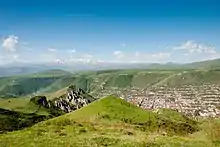
After the independence of Armenia, Goris was included within the newly-formed Syunik Province as per the 1995 administrative reform of independent Armenia.
In 2006, Goris State Institute of Pedagogy was restructured and turned into Goris State University to become the largest educational institute of Syunik.
As a result of community mergers in 2016, the municipality of Goris was enlarged to include 9 of its nearby villages.
Geography and climate
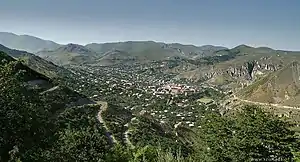
Goris is situated in the valley of Goris River, also known as Vararak River. The valley is surrounded with the Zangezur Mountains. The town has an average elevation of 1,385 metres above sea level. The surrounding mountains are famous for their medieval cave-dwellings carved out of the soft rock in the southern and eastern parts of the town. The Goris Wildlife Sanctuary is situated at the southeast of the town at a height ranging between 1400 and 2800 meters above sea level, covering an area of 18.5 km². Caucasian grouse, roe deer and brown bear are among the notable animals in the sanctuary.
Located in an alpine climate zone, the weather of Goris is characterized with mild snowy winters and hot summers. The average temperature in January is –1.3 °C and +19 °C in July. The annual precipitation level is between 500 and 600 mm.
| Climate data for Goris | |||||||||||||
|---|---|---|---|---|---|---|---|---|---|---|---|---|---|
| Month | Jan | Feb | Mar | Apr | May | Jun | Jul | Aug | Sep | Oct | Nov | Dec | Year |
| Daily mean °C (°F) | −7.7 (18.1) |
−5.5 (22.1) |
−2.5 (27.5) |
6.4 (43.5) |
11.7 (53.1) |
21.2 (70.2) |
23.2 (73.8) |
25.3 (77.5) |
18.0 (64.4) |
9.3 (48.7) |
3.7 (38.7) |
−2.3 (27.9) |
5.4 (41.7) |
| Average precipitation mm (inches) | 31 (1.2) |
36 (1.4) |
30 (1.2) |
38 (1.5) |
76 (3.0) |
58 (2.3) |
46 (1.8) |
38 (1.5) |
47 (1.9) |
38 (1.5) |
27 (1.1) |
24 (0.9) |
524 (20.6) |
| Source: plusninety.ru[8] | |||||||||||||
Demographics
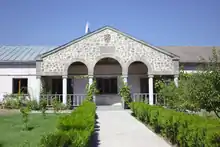
Population
Currently, the residents of Goris are entirely Armenians. However, the population suffered gradual decline since the collapse of the Soviet Union.
By the end of the 19th century, 74.6% of the population in Goris were ethnic Armenians as per the 1897 census. The figure grew after the Sovietization of Armenia to reach up to 98.1% in the 1926 census.
Here is the population timeline of Goris since 1870:[9][10][11][12]
|
|
|
Religion
The Cathedral of Saint Gregory the Illuminator in Goris is the seat of the Diocese of Syunik of the Armenian Apostolic Church. It was constructed between 1897 and 1904. After being consecrated by Catholicos Mkrtich Khrimian in 1903, the church was officially opened in 1904. In February 1921, the Saint Gregory Cathedral of Goris was the location where Garegin Nzhdeh was announced as the Sparapet (commander) of the Armenian forces of the forthcoming Republic of Mountainous Armenia in a solemn ceremony. The church building has served as a regional history museum during the Soviet days.
Culture

The stone-pyramids of Old Kores located to the east of the modern town, is one of the most attractive sites in Goris. The old town is home to the 4th-century basilica of Surp Hripsimé.[13] The basilica was renovated during the 16th century. However it was closed during the Soviet period until its major renovation in 2010. Finally, it was reopened for the public in October 2013.[14]
Goris is a prominent cultural centre in Syunik. It has a cultural palace, a public library and a dramatic theatre.
The archaeological museum of Goris opened in 1948 is dedicated to the rich history of the Syunik region. The house-museum of Axel Bakunts has been operating in the town since 1970, while the Goris art gallery has been operating since 2001. Other museums in the town include the geological museum of Goris and the Local Lore Museum of Goris.[15]
Goris has a rich heritage in the music of Armenia and is a major centre for traditional musical instruments. It is the birthplace of the famous musician Gusan Ashot.
Goris is home to the annual Mulberry festival taking place annually during the month of August.[16]
Transportation
.jpg.webp)

The M-2 Highway that connects the capital Yerevan with southern Armenia and the Nagorno-Karabakh Republic passes through Goris.
The Goris Airport, is located 10 kilometers south of Goris, near the village of Khot. It has been closed since the collapse of the USSR in 1991. However, the Armenian government plans on reconstructing the airport and opening it to public and private service by 2016.[17] According to the central government, it is envisaged to operate starting from 2016. The airport will allow tourists to visit the Syunik region and Zangezur Mountains as well as the Tatev monastery and other summer resorts around the town.
Economy
_(04).jpg.webp)
Being home to many food-processing plants, the economy of Goris is mainly based on light industry. The home-made fruit vodkas are particularly good and famous in Goris.
Goris is home to the Vorotan Hydropower Plant opened in 1989 and considered one of the main providers of electrical power in Armenia. Other large industrial firms in Goris include the "Vosmar" company for asphalt concrete and crushed stone founded in 2002, the "Goris Gamma" for electronic devices founded in 2003, and the "Goris Group" for bottled spring water founded in 2005.
Goris is also a favoured destination of many local and foreign tourists, with a large number of hotels and inns. The towns largest Goris hotel is currently under major reconstruction process. The stone-pyramids of Old Kores is one of the most attractive sites in Goris.
Education
Goris is an important educational centre in Syunik. It has 7 secondary schools, 2 intermediate colleges, 7 kindergartens, 2 sports schools, 2 music schools and 1 art school.
Goris State University has been operating in the town since 1967. Branches of the State Engineering University of Armenia and Yerevan State Institute of Theatre and Cinematography are also operating in the town.
Goris is also home to the Goris Kh. Yeritsyan State Agricultural College.
Sport
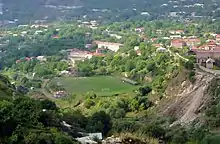
Football, chess, boxing, artistic gymnastics, volleyball and basketball are among the most practiced sports in Goris. The sport sector in the town is served by the Goris children's and youth sport school (opened in 1951), the Goris regional children's and youth sport school (opened in 2006), and the Albert Ordyan chess school.
Zangezour football club had represented the town in professional competitions between 1982 and 1997 when they were forced to quit due to financial difficulties. They played their home games at Goris City Stadium, winning the first place of the Armenian First League (2nd division) on 2 occasions.
International relations
Twin towns
Notable people
- Axel Bakunts (1899-1937), Armenian novelist
- Gusan Ashot (1907-1989), Armenian gusan
- Sero Khanzadyan (1915-1998), Armenian novelist
- Yuri Bakhshyan (1947-1999), Armenian politician
References
- "2011 Armenia census, Syunik Province" (PDF). National Statistical Service of the Republic of Armenia.
- Report of the results of the 2001 Armenian Census, Statistical Committee of Armenia
- "Population estimate of Armenia as of 01.01.2016" (PDF).
- "Նախատեսվում է իրականացնել համայնքների խոշորացման 14 պիլոտային ծրագիր - ԳՈՐԻՍԻ ՄԱՄՈՒԼԻ ԱԿՈՒՄԲ". gorispress.am.
- "Archived copy" Капан (in Russian). abp.am. Archived from the original on May 5, 2010. Retrieved August 28, 2009.CS1 maint: archived copy as title (link)
- "Syunik.am - Goris". Archived from the original on 2014-04-28.
- Armtown.com - ԼԵՌՆԱՀԱՅԱՍՏԱՆԻ 85-ԱՄՅԱԿԸ ՆՇԵՑԻՆ ՄԻԱՅՆ ՍՅՈՒՆԻՔԻ ՄԱՐԶԿԵՆՏՐՈՆՈՒՄ Archived 2011-07-16 at the Wayback Machine
- "armeniaguide: Goris, Armenia". plusninety. Archived from the original on 2013-04-21. Retrieved 2016-02-01.
- "Հայաստանի Հանրապետության բնակավայրերի բառարան" (PDF). Armenian State Cadaste. 2008. p. 63.
- "Демоскоп Weekly - Приложение. Справочник статистических показателей". demoscope.ru.
- "Зангезурский уезд 1926". ethno-kavkaz.narod.ru.
- http://armstat.am/file/doc/99483273.pdf
- "Հին Գորիսում վերականգնված Սուրբ Հռիփսիմե եկեղեցին կվերաօծվի".
- "Վերաօծվեց Գորիսի Սբ Հռիփսիմե եկեղեցին - Syunacerkir.am". www.syuniacyerkir.am.
- "Գորիս. Ակսել Բակունցի տուն-թանգարանը նորացված ցուցադրությամբ - ԳՈՐԻՍԻ ՄԱՄՈՒԼԻ ԱԿՈՒՄԲ". gorispress.am.
- Tours, Barev Armenia. "Թթի փառատոն Գորիսում - Բարև Արմենիա Տուր". barevarmenia.com.
- "Waiting rooms and cafes to be constructed at stations of Tatev aerial tramway".
External links
| Wikimedia Commons has media related to Goris. |
| Wikivoyage has a travel guide for Goris. |


